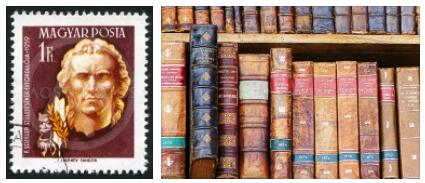As a writer, sacred speaker and statesman he explained a very fruitful activity. His main work: Guide to Divine Truth, made the struggles for the faith decide in favor of Catholicism. For his sermons, collected at the end of his life, he is rightly considered one of the greatest representatives of the literary Baroque style.
In the footsteps of Pázmány, significant religious literature arose. In 1626 the complete translation of the Catholic Bible was published, by the Jesuit Giorgio Káldi (1573-1634) begun and completed for the Old Testament by his brother, father Stefano Aratore or Szanto (1541-1612). At the same time the collection and revitalization of religious songs began.
Among the Protestant writers of this time stand out the elegant translator of the Psalms, Alberto Szenci Molnár (1574-1634), who also published a Latin-Hungarian grammar and vocabulary, and Giovanni Apáczai Csere (1625-1659), the first popularizer of doctrines of Descartes. The authors of the great synthetic historical works and collections of sources (Stefano Brodarics, Nicola Oláh, Antonio Veranzio, Francesco Forgách, Nicola Istvánffy) continued to write in Latin, while the historians and diarists of Transylvania (Gregorio Pethő, Giovanni Szalárdi, the Prince John Kemény, Nicola Bethlen), used almost exclusively the national language.
And it was in Hungarian that Count Nicholas Zrinyi (1620-1664), creator of epic poetry in grand style, expressed the ideas and feelings of his great soul. Versed in all the culture of his time, he, thanks to his profound Catholic sentiment, is above all close to Italian literature and art.
His early lyrics show traces of marinism; his heroic epic: The siege of Sziget (1651), was born under the influence of Virgil and Tasso; while in his strategic and political works (Re Mattia, The remedy against the Turkish poison) he draws on the thought of Machiavelli and the Italian writers of the Reason of State. But as it remains original in the ardent prose of these works, so it is absolutely individual in its epic: the poetic genius of Zrinyi gives the elements taken from the epic and chronical tradition the security of the structure, the incisive characteristic features, pouring out the religious pathos of the Counter-Reformation. and the spirit of sacrifice that makes his hero the symbol of the whole troubled nation.
Much closer to the taste and culture of his readers was Giorgio Gyöngyösi (1629-1705).
In his narrative poems (Venus de Murány, The Risen Phoenix, etc.) he presents himself as a student of Baroque art. A lover of descriptive pomp and lyrical decoration, he accumulates mythological, allegorical and moral images. His sonorous verses, with a lively rhythm and varied rhymes, had a lasting influence on the poets of the century. XVIII.
According to thenailmythology, the drama at that time was mainly cultivated in schools. Only during the 1700s, thanks to the Piarists and Paulines, did the Latin of the Jesuit scholastic drama be replaced by Hungarian. The most effective Piarist authors (Andrea Dugonics, Cristoforo Simai) mark the transition to profane theater, of which there are only two seventeenth-century memories left: a drama on Lazzaro (1646) and a Comicotragedia (1693) by Giorgio Felvinczi, who underwent the influence of the then fashionable Italian theater in Vienna.
Towards the end of the century, the country freed from the Turkish yoke with imperial help was treated by Vienna as a conquered province. Against this new oppression, Francis Rákóczi II, prince of Transylvania, gathered what still remained of strength in the nobility and in the people. His war for freedom, which in 1711 ended with the defeat of the kuruc, was the main inspiration of popular poetry of the time. Ballads of rich drama are born: songs of outlaws lament the sufferings of the heroes of freedom, military songs incite struggle. With this poem the popular song was enriched with a new content and new forms, which often find an echo even in the poets of very recent times.
The physical and spiritual exhaustion of the nation in the decades following Rákóczi’s exile did not favor the literary life.
The only prose writer of the first half of the century. XVIII was Clemente Mikes, Rákóczi’s faithful companion in exile in Rodosto (Turkey), in whose Letters the reminiscences of French readings prevail over the immediacy of the narration of his own events and experiences. In the lyric the Jesuit Francesco Faludi (1704-1779) brought as a new voice the easy grace of the Rococo spirit and the polyform melody of the Metastasian arias. The only representative of the aristocracy in national poetry was Baron Ladislao Amadé, who was also more of an architect of the form than a real poet. The retrospective studies, the syntheses of the past, occupy the best spirits of the time. David Czwittinger compiled in 1711 the first biographical lexicon of Hungarian writers (Specimen Hungariae Literatae); Pietro Bod in his Magyar Athenas (1766) presented the life and activity of over 500 authors; Matteo Bél, an eminent historian, was the initiator of the Hungarian geographic science (Notitia Hungariae). The Annales (1761-1770) George Pray represent a real treasure of rigorous historical and acute judgments research. The 43 volumes of the Historia Critica (1778-1817) by Stefano Katona became the most precious source for the historiography of the following century. Giovanni Sajnovics with the Demonstratio idioma Ungarorum et Lapponum idem esse (1770) laid the foundations of Hungarian linguistics. Count Samuele Teleki erected a magnificent monument to the neo-humanistic culture of his class by collecting and publishing the works of Janus Pannonius (1784).




